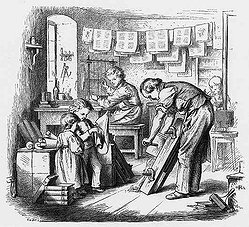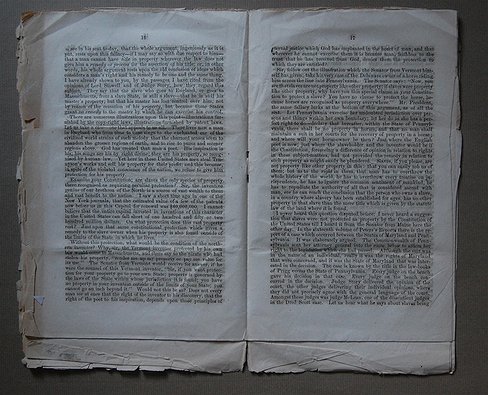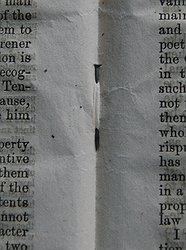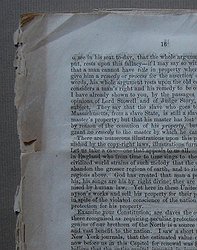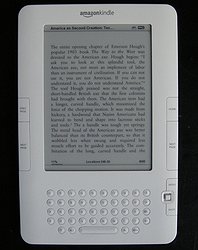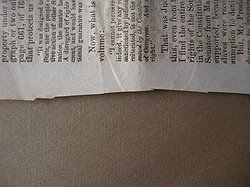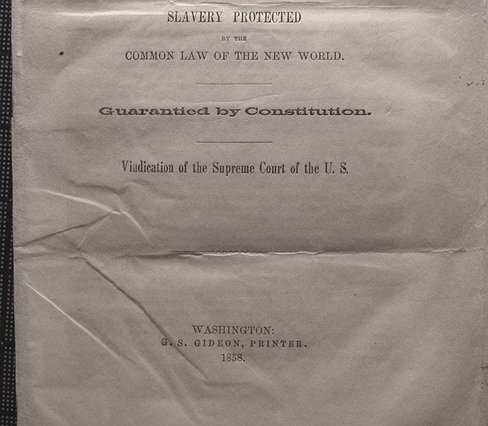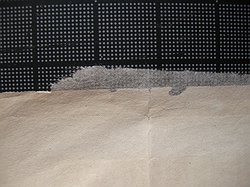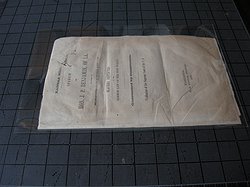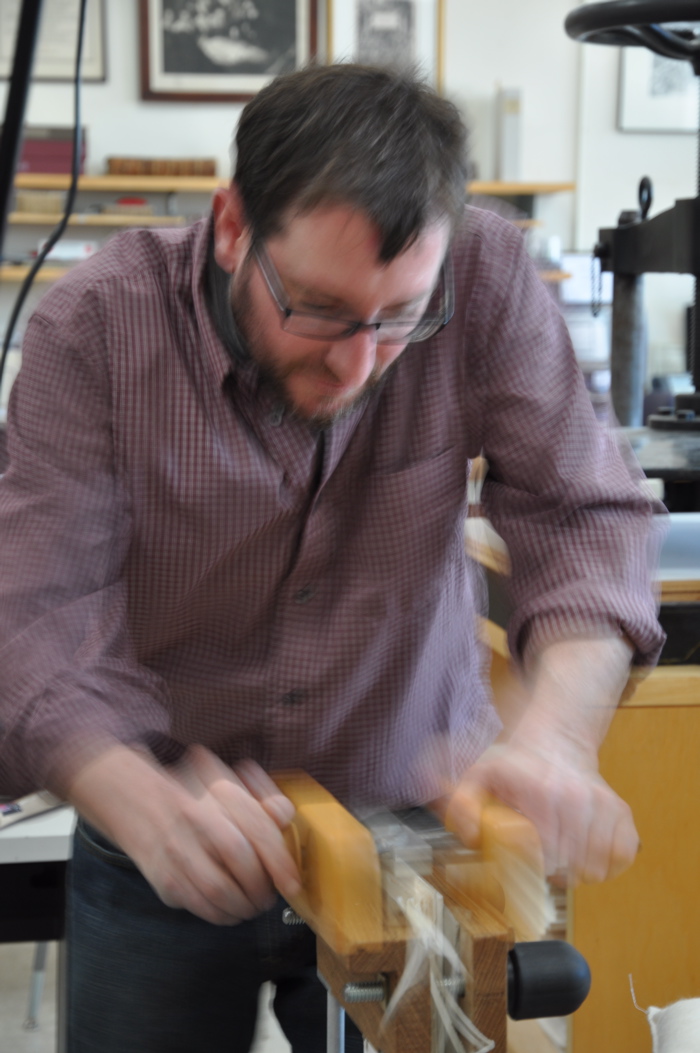A book conservator often enters into public perception heavily colored by, and often confused with, romantic notions of a “Master Craftsman,” “Master Bookbinder” or “Master Restorer.” In a world where many use their hands only to tap at a keyboard or lift a cup of coffee, the idea of a craftsman seems refreshingly simple, a bit anachronistic, very poetic and entirely appealing. Fortunately (or perhaps unfortunately!) these romantic ideas of a bookbinder bear little resemblance to what I do.
Although the terminology is somewhat debatable, in North America a bookbinder is usually someone who makes new fine bindings, or binds small editions, or repairs old books, often by putting new bindings on them. A book restorer, often working for the antiquarian or rare book trade, restores a book to an imagined, often pristine state, previous to damage, use or age. Many also make period bindings. (1) A book conservator attempts to preserve all the information that a book embodies, and ideally tries not to alter or change any existing element. Although conservators employ a full arsenal of craft skills, they also must know the history of book structure, be familiar with a wide variety of materials, have knowledge of preventative conservation and also understand methods of documentation. (2) The process is decidedly prosaic and cautious, and tends to adopt a scientific methodology.(3)
In contrast, bookbinding, or crafting an object, involves creating something, usually from raw or partially prepared materials. Craft often implies, at least today, a personal relationship to the work. Craft often involves handwork, and numerous advertising campaigns have seized upon this to an absurd degree—handcrafted beer, anyone? Conserving an object, except in some cases, involves examining, documenting and treating an object that already exists. Conservators are very much subservient to the object they are working on, and strive not to interject their personality or time period onto that object. Sometimes such subservience to an object verges on a kind of slavery in regard to the discipline that it requires. (I do enjoy the freedom and fun of doing some bookbinding every now and then.) Conservation is creative in a problem-solving sense, but not in the sense of making something new. That is a fundamental difference between bookbinders and book conservators.
Perhaps the most important, fundamental concept in the philosophy of modern conservation is that of reversibility. Ideally, every treatment is reversible—meaning that in the future, if necessary, the object could be returned to a pre-treatment state. Practically, this is never 100% possible. Therefore, any intervention is a decision that I, or any of my peers, never take lightly. A mistake or error in judgment could possibly distort and diminish future generations’ understanding of the history of books.
People often ask me if I get nervous or hesitant when working on items that are worth many times my annual income. Truthfully, I don’t—because each treatment is carefully planned and broken down into a series of small steps. I depend on my training, the concept of reversibility, and twenty years of experience to accomplish each step cautiously, yet confidently.
What makes conservation particularly interesting, and challenging, is how theory and praxis come together in the course of an actual treatment. For this article, a longtime private client gave me permission to reproduce images and record some of the treatment process associated with his 1858 pamphlet. (4) What follows is a record of some of the issues, challenges and discussions that arose in the course of the examination, documentation and treatment of this seemingly simple book. In fact, this pamphlet might represent the simplest book structure of all: just a single straight pin pushed through two holes.
The pamphlet is a speech by the Honorable J. P. Benjamin of Louisiana, titled “Slavery Protected by the Common Law of the New World. Guaranteed by Constitution.” Washington: G.S. Gideon, Printer, 1858. At first glance it appeared to be a typical 19th century pamphlet, of which there are probably hundreds of thousands in existence. Upon closer inspection, I noticed that this pamphlet was not sewn, stitched or bound, but was held together with a pin. (5) In this case, the head of the pin was rather small and was not causing mechanical damage to the adjacent pages. It was also apparently stainless steel and was not rusting. I had never seen a pamphlet like this, apparently in a temporary binding, pinned through the fold so that the pages functioned, flexed and draped normally. (6) I still get excited when I encounter a novel or unusual binding structure like this one!
At first, the owner wanted to have the title page photocopied onto some blue handmade cover stock, and then have the pamphlet sewn with linen thread. This would be a common, sympathetic treatment approximating how a pamphlet from this time period would have commonly been issued. But because this pamphlet had the unusual pin (and because it was the first time I had seen this type of binding), he was amenable to a treatment proposal that recommended retaining the pin as historical evidence.
Some readers may wonder what sort of historical evidence this pin may offer, and indeed question if it has any value at all. Why would this very simple binding have value? Is it not just a straight pin? But questions of value are outside of a conservator’s domain: My job is to preserve all physical information, not to pass judgment on what is or is not meaningful. In practice, however, often compromise has to take place.
That said, for me, this pin raises many questions. What could this pin tell us about the working methods of printers and binders from this time period? Why was this pin put there? Was it meant to hold the pages together until they could be sewn? Was this pamphlet meant to be distributed with this pin in place? Was this a common type of temporary binding? Did the binder (or printer) run out of sewing thread? Did their needle break and preclude finishing the sewing? Was the information printed extremely time- dependant and did it have to be rushed to the readers? Was this an extreme cost-cutting method? Was this pamphlet to be bound together with others fairly soon? Were the binders out sick that day? Although these and other questions may never be answered, by retaining all evidence pertaining to these questions, someday an answer may be found. (7)
After discussing some of these initial observations with the client, I prepared a more detailed written treatment proposal. The first part includes a description and condition of the artifact. The next details what I think the best course of action is, notes other treatment options, and highlights any potential risks or possible complications. We decided on a relatively conservative approach of keeping the pin in place and stabilizing some of the other problem areas.
Every object exists in time and bears witness to that existence through various marks, such as surface dirt and stains. Even “identical” printings from the same time period develop unique identifying characteristics based on their life history. When I look at an object, these small tears, soiled areas, creases, surface dirt and accretions present a visual record of how the object was used.
I call this type of information “use value” (8). It is debatable as to exactly what kind of value these marks hold, but these textual extraneous elements do make concrete the fact that we are looking at a document that was made 150 years ago. Collectively, these marks (defects?) serve to identify something old, used and having existed in time. This in itself is becoming somewhat a rarity in our current cultural climate—things break long before they develop aesthetic markings from wear. Personally, I find the aesthetics of wear and decay pleasing, fascinating, unique and often worth preserving.
Preserving use value serves to anchor an object in a particular place and time. Unfortunately, some collectors value the pristine more than the use value, and will sometimes go to extraordinary lengths to restore an item to an imagined, previous state. The premium value that the current antique market places on the pristine also exasperates this preference. But I am sure this will change as not only worn objects become increasingly rare, but as non-digital objects also become scarce. Since digital images are often consumed in exactly the same context, on the computer screen, they become homogeneous, indistinguishable and endlessly similar. This contrasts starkly with the unique, individual life history visually present when one encounters an actual object.
Another interesting aspect of this simple pamphlet is that it was partly trimmed with a scissors. Technically, I assume, this pamphlet would be considered by bibliographers as untrimmed, since almost all of the page edges were made up of the natural deckle. It is interesting, and potentially important, to note the unmistakable use of a scissors and to see the way this paper was rapidly cut. (9)
To my eyes, these rapid, crude cuts indicate the speed with which the workers of this time period worked, which in turn may indicate how much they were paid for the work—in this case, likely very little, given their careless aplomb. It is a bit puzzling as to why only these small areas of the page were trimmed. Were these odd-shaped sheets to start with? In all fairness, however, these cuts were not meant to be seen, as the workers who made them would have known, for the sheets would have been trimmed more precisely, with a board shear or card cutter, when the paper wrapper was applied and the book sewn, or when this pamphlet was bound with others into a collection.
Even the creases, the folds and the soiling on the outside, when the pamphlet was folded, give us some information about how it was used. This was a working document, possibly carried and stored for tri-folding. In this case, the client and I decided to lightly surface clean the entire pamphlet and slightly flatten out the folds to make it possible to turn the pages without causing further damage. As always, the amount of cleaning depends on a variety of factors. In this case, preserving the more documentary features of use value were more of a concern than improving aesthetic legibility. But one must consider many variables when embarking on a seemingly innocuous, yet totally irreversible, act like surface cleaning. Additionally, unless done with training and care, surface cleaning can often abrade the paper, create stark contrasts between soiled areas and stains within the paper, and sometimes irrevocably damage the object. On the whole, I have seen more damage than benefits caused by attempts at home cleaning. (11)
After the document was cleaned, many small creases and folds were flattened in preparation for the mending. The tears were repaired with an appropriate weight Japanese tissue adhered with wheat starch paste. All materials and adhesives used in conservation are carefully selected and rigorously tested to meet the highest possible standards of longevity. A basic principle in paper repair--in fact, in any type of repair-- is to always make the repair slightly weaker than the surrounding material, so that if the object is stressed the repair will fail and not damage the original material.
The somewhat crude scissor cuts on the page edges were also preserved by carefully trimming the repair tissue along the original edges. Again, in different circumstances, losses could be infilled to create visual continuity. Finally, the pamphlet was housed in a Melinex 516 “L” seal envelope that allows visual access to the exterior, protects it from abrasion and is easy to remove to read the text. The goals of the initial treatment proposal were met: the pin was left undisturbed for possible future interpretation, most of the use value reflected in the surface soiling and creases was retained, “dog-eared” folds that were causing the leaves to stick together were relaxed and flattened, tears were repaired and the scissor cuts were retained.
Although this pamphlet is perhaps the simplest of book structures, it revealed a number of unanswered questions concerning its production. In this case, the conservation of the pamphlet did not address aesthetic improvements, but instead preserved potentially valuable information about yet another unwritten chapter in the history of bookbinding. Another situation may require extensive attention to aesthetic concerns. That is one reason why I find this field so interesting and continually challenging: No two items are the same, and each one demands individual, customized solutions to its problems while balancing the demands of the owners or custodians.
The types of items that I treat vary immensely, as well as the types of treatments I perform--which helps to keep the work new, interesting and challenging. What doesn’t change is the commitment to high levels of professionalism that my peers and I continually strive for.
Perhaps I am entertaining some romantic notions of my own when believing that preserving the relatively small number of books I can in my lifetime will make any sort of difference in the grand scheme of book history and human history. Or perhaps, conservation, books and romantic notions are inexorably intertwined in ways we will continue to discover anew.
So how did I end up in this somewhat obscure field? I would have to credit Pinchpenny Press and the Goshen College English Department, its sponsor. One of my projects as a senior was to produce a book of my own poetry, Stone Styrofoam (1988). Although, thankfully, the poetry has long faded from view, the experience of making, producing and distributing a book stuck with me. I recall using the typesetting machine, getting half-tones made for the illustrations and cutting and pasting them by hand. I enjoyed the physical processes of creating that book almost as much as the writing. After graduating from Goshen College, and moving to New York City, I found myself working at Gotham Book Mart as a stock clerk. In an effort to avoid the tedium of shelving books, I offered to “repair” some of the used books.
With some instruction from the manager, and a well used copy of Arthur Johnson’s Thames and Hudson Manual of Bookbinding nearby, I glued loose joints, did some minor paper repairs, etc. This encouraged me to start taking some classes at the Center for Book Arts, taking private lessons with Tim Ely, and beginning to acquire some tools and equipment. I've always been something of an autodidact, so much of my early learning was through reading books and experimenting on my own.
Originally, I was more interested in bookbinding and book arts, but a part time job as a conservation technician led to a full time job at Columbia University's Conservation Lab, where I was able, unofficially, to take advantage of the educational opportunities that the Rare Book School and the MILS Advanced Certificate in Conservation offered at the time. There I honed my skills over six years, eventually working exclusively on special collections materials, then leaving to start my own business. And it is in my studio, surrounded by the machinery of book conservation—a standing press, a lying press, a board shear, sewing frames, a suction platen, a Nilfisk HEPA vacuum-- where I write these words. I'm satisfied and lucky to have found a profession that is a good match for my abilities and interests.
NOTES
1. Not romanticized, but entering into common parlance, is the term conservationist. This is not traditionally a book-related term, but refers to someone who measures tree rings, collects core samples from glaciers, counts birds, etc. Then again, language changes!
2. According to the American Institute for Conservation of Historic & Artistic works, a conservator must be proficient in twelve basic competencies: respecting the unique and individual character of a book, understanding its significance as cultural heritage, knowing its place in the history of technology, being aware of how the book is used by society, knowing conservation terminology, possessing a working knowledge of scientific principles, understanding health and safety concerns, knowing the processes of deterioration and decay, using current methods of preventive care, understanding examination techniques, recording documentation and performing treatments. More information is in the paper “Defining the Conservator: Essential Competencies,” accessed Dec. 29, 2009. http://www.conservation-us.org/_data/n_0001 /resources/live/definingcon.pdf
3. Personally, I have severe doubts that a field like conservation—any type of conservation—can become completely scientific. Two major impediments are the unique and irreproducible nature of any treatment and the degree of subjectivity inherent in determining a course of treatment and assessing its outcome. Of course, using scientific analysis as a component of a conservator’s toolbox is very important and has undoubtedly prevented or delayed the premature obliteration of countless objects.
4. Thanks, “Mr. T.”
5. I wrote a little more about this pin, and a bit about pins in general, on my blog. Accessed Dec. 30, 2009.
6. When I first begin to seriously examine a book, an odd reversal of subject and object takes place. Normally, the book is the object that leads to a subject. During a conservation treatment, however, in using my “conservation eyes” the object becomes the subject: I am looking at the book, at the material and structural supports, at the ink on the page.
7. One of the nice things about a blog is that sometimes others add informative comments. In this case, Bill Hanscom found a similar pamphlet with a pin from 1851. Although I was informed of this after the treatment was completed, Bill’s comment contains two important pieces of information. First, this pin binding is not unique, and there are likely other extant examples, or at least pamphlets that bear the marks of having been pinned together. Second, someone else thought it was unusual enough to preserve and post photos of it on Flicker. Accessed Dec 29, 2009. http://www.flickr.com/photos/lincolnbear/sets/ 72157622626577467/
8. This is not to be confused with the Marxist sense of “use value,” but I’ve racked my brain and failed to come up with a more discrete, concise way to express what I mean.
9. How to use a scissors is perhaps a forgotten and undocumented craft skill. In 1927, E. W. Palmer devoted a full page to illustrating how to properly use one, in his exemplary book, A Course in Bookbinding for Vocational Training. Accessed Dec. 29, 2009. http://jeffpeachey.wordpress.com/2009/ 10/21/using-a-scissors/
10. Librarians, booksellers and private collectors take heed! I have seen many clients erase from books various notes, marginalia and other previous ownership marks that they later learned were meaningful or important to the book. Examine all marks closely. I once purchased a signed Ricky Jay book very cheaply because the dealer thought the signature was just scribbles. Thankfully, he didn’t erase the scribbles.
